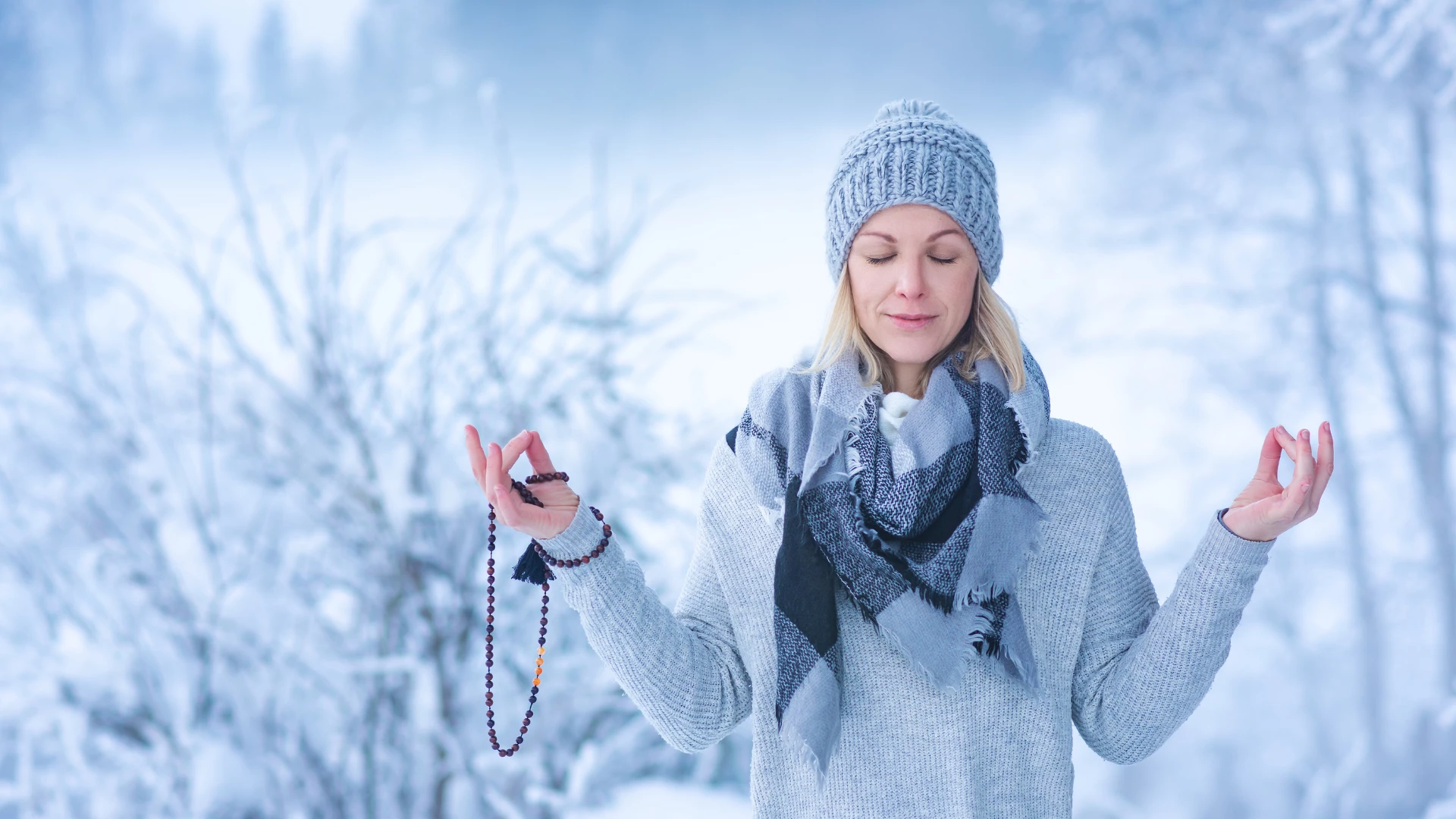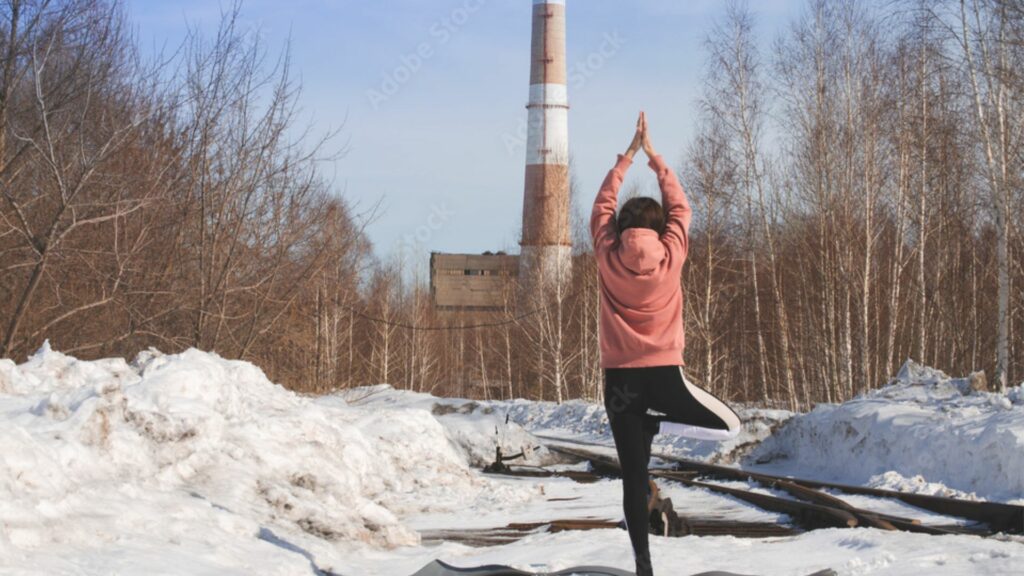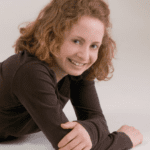Yoga for the Winter Blues: Ease Seasonal Affective Disorder

Article At A Glance
Could yoga for Seasonal Affective Disorder (SAD) take the edge off, easing symptoms and making the winter feel brighter? If you are one of 10-20% of all adults who experience the winter blues, try yoga to bring energy, lightness, and greater ease. Learn how here.
Aaah, the winter blues, that malaise when the cold, quiet winter months feel like they’re dragging on forever. Ten to 20 percent of the general population experiences Seasonal Affective Disorder (SAD). It can hit anyone, yet it is more common in women (1). Could yoga for Seasonal Affective Disorder take the edge off, easing symptoms and making the winter feel brighter?
Yoga can’t address the primary known cause of Seasonal Affective Disorder: a lack of natural sunlight. We need sunlight for healthy serotonin levels. This impacts not only mood but also our circadian rhythms (our internal clock for sleep and waking) (2) and even our digestive health. Yet yoga can bring some energy, lightness, and greater ease to tired, “blue” bodies. We know that the body, mind, and spirit are undeniably connected. Yoga can bring a bit of energy, lightness, and ease to the mind, thus taking the edge off some of the mental blues (3).
Yoga for Seasonal Affective Disorder (SAD): Asana, Pranayama, and Meditation

The following yoga sequence—including basic poses, breathwork (“pranayama”), and mindfulness exercises—is meant to ease Seasonal Affective Disorder. You can practice it all from a standing position so that you can bundle up and take it outside for a bonus dose of sunlight for that important serotonin balancing. Yet if that’s not feasible, and if practicing seated serves you better, you can very much do that instead.
Here’s one caveat before you jump into the sequence, as is typical for yoga practice for any particular condition. Especially in moderate to severe cases, consider yoga a complementary treatment unless your doctor advises you otherwise. In other words, be sure to get evidence-based treatment for whatever you’re experiencing. Additionally, always consult your healthcare provider before beginning yoga or any other physical activity practice or program.
Opening Breathwork: Ground and Energize
- First, find firm grounding in your stance, feet at hips-distance apart. Feel rooted through your feet, your kneecaps lifting to power up through your strong legs. If you’re seated, feel that rooting through your seat. At the same time, grow up tall through your spine, as if someone was gently pulling you upward by a string at the top of your head.
- Long, deep inhalations can energize us by every so slightly activating the sympathetic nervous system (fight/flight). That can be helpful in cases of low mood when our energy can also feel low.
- Breathe in for four counts. Try to fill up in three dimensions: side-to-side, front-to-back, and pelvis-to-throat. Breathe in through your nose if possible. Winter can also come with nasal congestion, which might make breathing in through your nose challenging. Imagine energy entering your body with that breath in. It’s there for you!
- Breathe out for three counts, less than your inhalations. Imagine sluggishness and those “blahs” leaving your body as you do so.
- In the next few breaths, see if you can adjust your count: five counts inhale and four counts exhale, six counts inhale and five counts exhale. Yet avoid straining. Don’t go to the point where you feel out of breath. That can be counterintuitive to the goal here of finding calm energy.
- After 5 to 10 breaths like this, breathe normally. Notice how you feel.
Gentle Standing Backbend: Yoga for Seasonal Affective Disorder
When someone’s feeling down, we can sometimes see it in their body language: slumped shoulders, rounded spine, dropped chin. Backbends take our spines in the opposite direction, counteracting that downcast physical energy and maybe even catalyzing a shift in our mind and spirit.
- Start by checking back in with your stance, ensuring you’re staying rooted through your feet but lifted up through the top of your head. You’re ready for your winter yoga poses!
- Interlace your fingers at your lower back. If possible, touch your palms together.
- Gently roll your shoulders up and back, opening through the fronts of your shoulders and collarbones. Especially if you have a bendy spine, make sure that you’re not jutting the front of your ribcage out. Instead, feel your front ribs soften down toward your pelvis.
- As you breathe in, feel your spine grow ever so slightly taller, like a flower growing up to the sun. As you breathe out, let the top of your spine lengthen backward. That will create a mild backbend. Be careful not to drop your head back, leaving your neck unsupported. Instead, look straight upward. If you’re practicing outside, maybe you can even spot a cloud or two in a fun shape!
- If you’re outside, and there’s sunshine, feel it warm the skin of your face and neck (and whatever else you don’t have bundled up!). Know that even getting that little bit of extra sun can help ease that down-in-the-dumps feeling of the long winter months.
- Hold your mild backbend for 3 to 5 breaths total. Then release your clasp and gently shake your hands and wrists. Take another breath or two to notice how you feel.
Side Bend and Twist: Find New Space

- Interlace your fingers the other way, your arms in front of you with your palms facing away. Reach your clasp forward and then up to the sky. Your palms should be facing upward toward the sky, not toward your head.
- Side bend to your right. Make sure to keep your right side body (the bottom side here) nice and long. Avoid sacrificing length and space there to feel like you’re getting a deeper bend.
- If it feels okay on your neck, look up to the left (the direction opposite of your side bend). Can you feel spacious and expansive in your yoga poses for the winter?
- Stay here for 3 to 5 breaths. See if you can feel longer through your spine as you breathe in, and move just a bit deeper into your side bend as you breathe out. Go slowly and mindfully without sacrificing that length in the right side of your body.
- Bring your spine back up to fully vertical as you breathe in, coming out of your side bend. As you breathe out, twist to your right, keeping the same shape with your arms.
- Stay in the twist for 3 to 5 breaths. See if you can find just a bit more length up through your spine as you breathe in. See if your upper back can turn just a bit more into the twist as you breathe out. These will be subtle changes, but subtle can be meaningful!
- As you breathe out, come out of the twist by facing back squarely center. Release the clasp, shake out your hands, and/or take any other movement that feels good and needed.
- Repeat steps 1 through 6 on the other side, taking the clasp again and then side bending to your left.
- Return to Mountain Pose (Tadasana). Before proceeding, take another last moment to notice how your yoga for Seasonal Affective Disorder feels.
One-Legged Balance: Yoga for Seasonal Affective Disorder

- From Mountain Pose, begin to gradually, mindfully shift your weight onto your left leg. Just as gradually and mindfully, draw your right knee in toward your chest.
- Raise your leg high enough so that you can interlace your fingers directly below your right knee. You’ll be supporting that leg with a firm but easy hold. Alternatively, if it feels more stable for you, you can also keep your hands on your hips. Take the time and make the adjustments that you need.
- If this balance feels inaccessible to you, another option is to take Tree Pose (Vrksasana) with the ball of your right foot resting on the ground. Yes, that’s still Tree Pose! You could reach your arms up toward the sky or keep your hands at your heart center (Anjali Mudra). The point is to feel stable, knowing that you can balance as assuredly as the trees around you, whatever you face, even as nature sleeps in winter.
- Whatever balance you’ve chosen, hold it for 3 to 5 deep breaths total, or longer if it feels good to you. It helps to find a non-moving spot to fix your gaze. That can be a challenge, but not impossible if you’re practicing outdoors!
- Practice steps 1 through 4 by balancing on your right leg, and your left leg taking your balance of choice.
Noodly Arms: Move the Momentum
- Step your feet a bit wider than your hips. Feel grounded in your lower body but light and easy in your upper body.
- When our mood is low, we can feel stuck and stagnant in the body, which translates, to some degree, to feeling the same in the mind and spirit. So, time to move through your body! Begin gently twisting your upper body, side to side, in the rhythm that feels right to you.
- Let your arms naturally follow the movement as they will. Try to let them be as loose and soft as strands of cooked noodles. You might even gently hit your own body on each side as you move. It’s okay to feel silly! No one’s judging you. See if you can embrace the silliness and maybe even laugh a little. Many of us could use that in the long winter months, right?
- Continue for at least 30 seconds. If it feels good to you, keep going until it feels right to stop.
- When you’re ready to return to stillness, let the movement get smaller and slower until the momentum gradually dissipates, bringing you back to stillness. Return to Mountain Pose with your arms naturally hanging by your sides.
- Check in with your body. How’s your breath? Are there any notable sensations? What did it feel like to let momentum move through you?
Closing Meditation: Warm Sunlight
- Stand back in your Mountain Pose. Check back with those fundamental qualities and actions discussed at the beginning of this sequence. For the following, you can close your eyes, or if closing your eyes doesn’t feel comfortable for you, simply gaze softly ahead.
- If you’re practicing outside, once again feel the sunshine on your skin. If you’re inside, imagine that sunlight was shining down on you. You might even be able to bring back a sensory memory of what that feels like. For a couple of breaths, simply savor that feeling.
- Gradually, intentionally, imagine that warm light spreading throughout your body, soaking into every cell of your body. As a variation on a body scan, imagine that light moving through you from the top of your head to your toes: head/neck, torso, arms/hands, hips/buttocks, legs/feet. Take your time. Allow yourself to savor.
- Once the warm light has soaked into every cell of your body, imagine it emanating out past you: out of the top of your head and past your fingers and toes. Know that you can receive, and then reflect, light and warmth—even in the winter.
- Stay with this image, and this sensation, for at least 5 more breaths, but maintain it for as long as you like.
- When you’re ready, open your eyes if they’ve been closed. If you have them softly fixed ahead, focus your gaze.
- Notice how you feel—perhaps more open, easeful, and light? Whatever that might be for you, continue with the rest of your day or night. Know that, yes, light and warmth are still there. You can take it in and radiate it out. Your yoga for the winter blues can only help!
Also, read...
Yoga Practice at the Wall: 5 Poses to Soothe Your Body and Mind
4 Yoga Practices to Support Mental Wellbeing
12 Scientifically Proven Benefits of Meditation
Related courses
Keys to Finding Inner Strength: A Yogic Wisdom Path to Developing Greater Resilience
Somatic Yoga for Fascial Unwinding

Kathryn Boland is an RCYT and R-DMT (Registered Dance/Movement Therapist). She is originally from Rhode Island, attended The George Washington University (Washington, DC) for an undergraduate degree in Dance (where she first encountered yoga), and Lesley University for an MA in Clinical Mental Health Counseling, Expressive Therapies: Dance/Movement Therapy. She has taught yoga to diverse populations in varied locations. As a dancer, she has always loved to keep moving and flowing in practicing more active Vinyasa-style forms. Her interests have recently evolved to include Yin and therapeutic yoga, and aligning those forms with Laban Movement Analysis to serve the needs of various groups (such as Alzheimer’s Disease patients, children diagnosed with ADHD, PTSD-afflicted veterans – all of which are demographically expanding). She believes in finding the opportunity within every adversity, and doing all that she can to help others live with a bit more breath and flow!
- Dhuwka, Luvna et al. “Low circadian amplitude, and delayed phase are linked to seasonal affective disorder.” Journal of Affective Disorder Reports: Volume 10, December 2022. <https://www.sciencedirect.com/science/article/pii/S2666915322000877>.
- Wescott, Delainey L. et al. “Sleep in seasonal affective disorder.” Current Opinion in Psychology: Volume 34, August 2020. <https://www.sciencedirect.com/science/article/pii/S2352250X19301460>. pp 7-11.
- Meesters, Alie N.R. et al. “Seasonal Patterns in Mindfulness in people with Seasonal Affective Disorder.” Journal of Affective Disorders Reports: Volume 8, April 2022. <https://www.sciencedirect.com/science/article/pii/S2666915322000348>.


